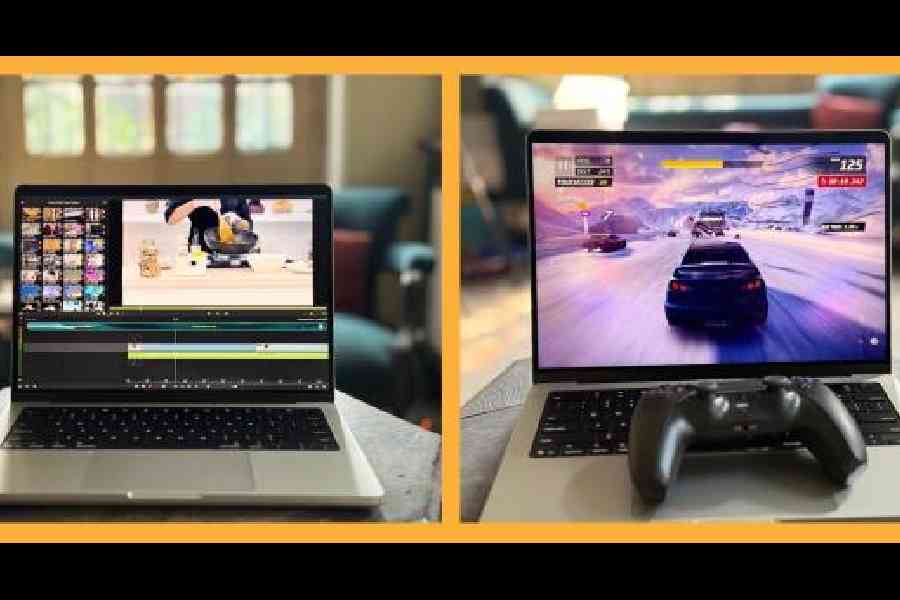The base MacBook Pro has been one of Apple’s biggest hits in recent years, especially since the M1 version defined what a base model laptop could be back in 2020. Every update since has delivered more and more power per dollar. And last year’s base M4 version set a new bar with a minimum of 16 gigs of unified memory and pro-chip level performance. This year, with the new base MacBook Pro with M5 here, we once again get some sizeable, meaningful improvements. They’re a bit more subtle this time, but altogether they are enough to make you upgrade.
The M5 chip comes with substantial performance gains, especially in the GPU department. This is happening in just one short year, which is impressive. But obviously, this machine is not for someone who already has the M4. If you’re coming from anything else that’s older, even a new Windows machine, this is exciting.
Fast and faster
The first reason to consider buying a new MacBook Pro with M5 is because of its internal storage, which is up to twice as fast. Now, this means the data or files you’re reading or writing — in other words, opening, copying, or creating files — happens up to twice as fast once again. So, big projects stored internally are going to open more quickly, along with some heavier apps as well.

Shapr3D's (left) physically-based rendering (PBR) allows instant visualisation of your 3D models with high-quality materials and lighting. And Draw Things: Offline AI Art is a resource-hungry image generator for which you can harness powerful AI models
Once again, working with files feels more instantaneous. Searching your entire drive with Spotlight and Finder should be a bit quicker. macOS updates will occur a bit faster and, of course, more intensive tasks can benefit since they rely on storage that is as fast as possible.
The MacBook Pro has become more configurable. For the first time, a base MacBook Pro can now be equipped with up to 4TB of this faster internal storage, which is a huge win for people who want a lot of storage. This allows you to have a seamless, portable laptop experience without the need for an external drive if your work or project files can fit within this pretty sizeable 4TB capacity.
If you’re on the go a lot and don’t want to be constantly plugging into external storage, you can now put some additional money towards storage. Long-term, more people regret not getting more storage than forgoing more power with processor or RAM that may not even be used.
Let’s talk about what you can do with the memory here, especially if you create a lot of content. With 153GB/s of unified memory bandwidth, users can work with large AI models on-device or manipulate massive scenes in 3D apps. This is much faster than last year’s M4 models. This extra bandwidth will make intensive workflows or tasks even quicker. Since again, the function of memory or RAM is to give your processor quick access to files or resources without having to dig through the rest of your storage, which is now faster. This will help with important, heavier pro tasks.
Built for the AI generation
But RAM or memory only gets you so far, which is why you’re likely curious how the M5 chip makes a difference. Compared to last year’s M4 model, we see some pretty decent gains CPU-wise. The M5 has a 10-core CPU with four performance cores and six efficiency cores, and a 10-core GPU. The chip features a next-generation GPU with a Neural Accelerator in each core, delivering up to 3.5x the AI performance and up to 1.6x faster graphics than the previous generation. M5 also includes a faster and more efficient CPU, an enhanced Neural Engine, and higher memory bandwidth that accelerates everything from launching apps to running large language models (LLMs) on-device. Additionally, it offers battery life of up to 24 hours, so users can take their pro workflows anywhere.
If you’re coming from one of these older models, on top of the faster memory, you’re in for a real performance treat in the CPU department. Where we see even more impressive short-term gains is with GPU performance. M5’s GPU is a whopping 30 to 35 per cent more powerful compared to M4’s.

LumaFusion (left) is a no-nonsense video-editing app that's enough for most amateur content creators. Or, you can play the latest AAA video game without worrying about GPU performance
The uptick in GPU performance, even from the last generation, is huge for tasks involving the rendering of any kind of advanced visuals, whether that’s a more graphically intensive game, a 3D model, or perhaps effects in Final Cut Pro or other photo and video-editing applications.
GPU horsepower is also great for on-device AI models and processes. The 30-35 per cent improvement is going to make a big difference if AI is involved in your workflow, which is becoming more and more the case as time goes on. And again, factoring in the faster memory and internal storage, this stacked performance really comes together to give you a very well-oiled, lightning-quick machine.
We have been using apps like Draw Things: Offline AI Art and Shapr3D: 3D CAD for designing manufacturing-ready models. These are extremely resource-hungry applications. When you first launch Draw Things, you need to download what is known as a model. There are a number of options, and these are very important when it comes to AI image generation.
Draw Things is a graphical user interface for Stable Diffusion. A model in machine learning, such as Stable Diffusion, is a trained neural network that has learned to generate images by analysing an extensive set of images and text. Each model uses different source images and text. Some people create different models based on art styles and content. Some are really good at people, and some are general-purpose. The MacBook Pro M5 is one of those machines that can beat the competition easily when it comes to generating images using these heavy models. What usually takes a couple of minutes to generate on many Windows laptops can be done here in a matter of seconds. We’re talking less than a minute. It makes a big difference if you need to generate hundreds of AI-powered photos per day or week.

The M5’s speedy performance, especially in terms of real-world feel, will be much more noticeable if you’re coming from Intel-based Macs or M1 Mac
In Shapr3D, making industrial designs takes plenty of bandwidth, and you need a machine that doesn’t feel sluggish. The M5 does the job. What about other applications? Users get up to 7.7x faster AI video-enhancing performance in Topaz Video when compared to the 13-inch MacBook Pro with M1, and up to 1.8x faster than the 14-inch MacBook Pro with M4. And up to 6.8x faster 3D rendering in Blender when compared to the 13-inch MacBook Pro with M1, and up to 1.7x faster than the 14-inch MacBook Pro with M4.
Make the call
You, of course, get the more updated MacBook Pro design with several input-output ports. The machine helps if you need more ports — there are three Thunderbolt 4 ports, an HDMI and SDXC card slot. You also have a 3.5mm headphone jack. And although we’re expecting some kind of more substantial redesign or overall refresh next year, the chassis is still pretty timeless, industrial and looks great in space black as well. You also get an extra USB-C port, like last year’s base M4 model as well. This is important for people who are connecting to external displays, dongles, peripherals, drives, and so on.
The model we have for review has 16GB RAM and 512GB of storage. Inside the box, you get a USB-C power cable and a 70W charger.
The 14.2-inch (diagonal) Liquid Retina XDR display offers 3024-by-1964 native resolution at 254 pixels per inch. There is ProMotion technology for adaptive refresh rates up to 120Hz. You have the option to get the Nano-texture display, which ensures there are fewer reflections on the screen. It will be helpful if you are always in a bright room with too many lights. But you have to pay extra for the feature.
The machine offers 1000 nits sustained full-screen and 1600 nits peak (HDR content only) brightness. Most people wouldn’t need such a bright screen, but here you have it. There are a lot of Windows laptops that are accurate in SDR but fail when it comes to HDR content. Here, the colour tracking as well as the brightness tracking are accurate. This one beats many professional monitors.
There is a 12-megapixel selfie camera with support for Centre Stage and desk view. So that’s also there if you need to take a lot of video calls.
The six-speaker sound system with force-cancelling woofers and support for Spatial Audio when playing music or video with Dolby Atmos on built-in speakers is the best money can buy. There is great bass to whatever you listen to, and there is an overall deep sound.
Battery life on the 14-inch Pro is even a little better than the already impressive 13- and 15-inch Airs. The M5 easily offered a whole, nearly non-stop nine-hour workday filled with everyday productivity apps, besides Lightroom Classic photo editing, and plenty of music listening thrown into the mix. The machine doesn’t get very warm to the touch or particularly loud with fan noise.
So, who is it for? Anybody with an M3 MacBook or older, and, of course, a Windows laptop. If you are in the market for a machine that offers a performance boost, the MacBook Pro with M5 delivers. The machine feels like the future... a future in which AI apps will rule. There are smart, practical updates, but what makes this machine unique is the unbeatable combination of lightning-fast performance and tremendous battery life.










